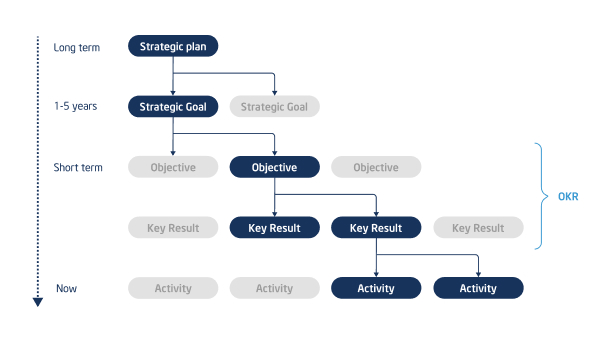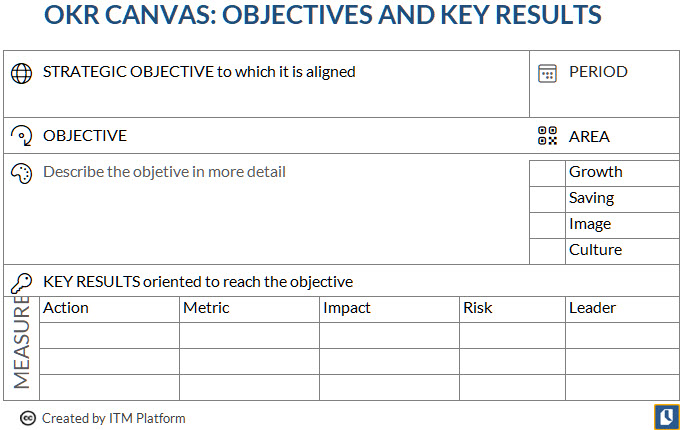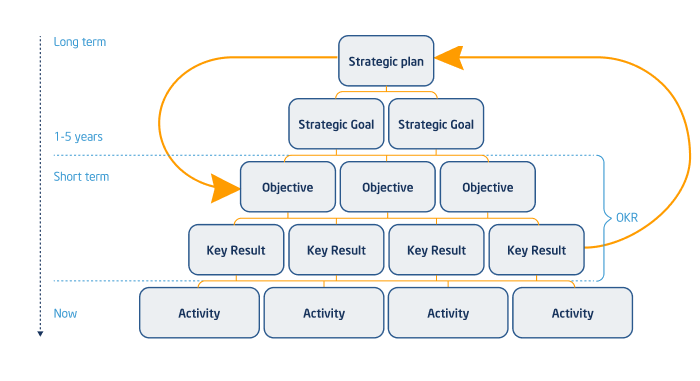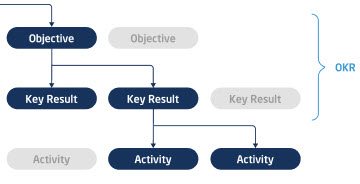
OKRs are a management tool designed to align work with strategy.
Between strategic planning and the execution of day-to-day activities are several hierarchical levels and a multitude of people transmitting ideas among each other. OKRs ensure that the finished result is reflective of the initial plan.

OKRs integrate into an intermediate level of the management model. In the context of an organization, they fill the tiers between strategic objectives and the activities that ultimately implement them.
OKRs are the drive belt between strategy and daily activity
OKRs are based on an objective and several key associated results. Expressed in a standardized model:
[Verb] [Subject]
[Key Result]
[Target][Date]
Let’s look at a concrete example:
Increase Productivity
Packages packaged
Average of 12/hour in the first semester
Average of 14/hour in the second semester
Calls answered
8 operator/day in the first semester
9 operator/day in the second semester
The activities are responsible for the key results and, ultimately, the realization of the strategic objectives.
OKRs solve any disconnect between strategies and their execution. They are also an effective motivational tool because they offer a purpose to daily activity.
We often do as we are commanded. But how often have we felt that we do not know why? OKRs ensure that daily tasks are both defined and explained.
According to Gallup, teams with committed staff have 21% higher productivity that those without.
OKRs help teams understand the purpose of their work.
Technology accelerates the distribution and tracking of work, but it does not explain why it is required.
Let’s remind ourselves of the structure of an OKR:
[Verb] [Subject]
[Key Result]
[Target][Date]
Those organizations that are accustomed to traditional management models may find it helpful to use a Canvas to arrive at the definition of their OKRs.
The following example built by the ITM Platform team serves as a helpful basis:

You can download this OKR Canvas in PDF or Excel formats
The following are some proven steps for generating OKRs with or without a canvas:
OKRs should be circular. Information should not only propagate down from objectives to activities. Information should feed back to the company’s management.

The third point suggests that action plans should be ready when results are not achieved or exceeded. Action should remain closely tied to the initially conceived plan. Improvising offers worse results.
For example, what if we only generated three customer leads from a Google Adwords campaign for which five were hoped for?
Without a plan for this eventuality, it might be tempting to increase the Adwords budget and adjust the OKRs that depend on it. This might involve reducing the ambition of their objectives or postponing their results.
Anticipate scenarios in which activities do not deliver their expected results.
If we plan for these scenarios, we can strategize more effectively. We might consider that Adwords might not be the best option. We might consider that the market is not responding well to the product and that structural changes are required.
Like all business management practices, there is no one-size-fits-all solution. Using the same measures may have the opposite effect in different organizations. Don’t try and stuff yourself into a shirt that doesn’t fit!
The following best practices cover aspects that need to be adapted for each case:
They look alike, but they are not the same. Objectives, OKRs, and KPIs (Key Process Indicators) are related but serve different purposes.
| Objectives | OKRs | KPI |
|---|---|---|
| A single sentence SMART (Specific, Measurable, Achievable, Relevant, and Time-placed) Delivers a result | It is a management unit Non-measurable target Measurable results | Quantifiable data Requires data source High periodicity Measure daily operations |
| Increase sales by 20% in December | Increase sales with 10 new customers, Q1 30% cross-selling | Monthly income |
As shown in the table above, all three are hierarchically related. In turn, objectives define the OKRs, and KPIs measure the key indicators in the overall running of the business.
Using OKRs does not guarantee success. While it is an intuitive mechanism, bad practices can cause them to fail.
The most common risks are:
There is a threefold link between OKRs and projects:
Projects as a mechanism for the materialization of OKRs
Remember the hierarchy between OKRs and the activities that will materialize them.

Activities will often be complex and will require a team. What is the best tool to manage complex and multidisciplinary work? Projects, of course!
OKRs as a control mechanism for long-term projects
In year-on-year projects, OKRs can be an exciting tool to control their results.
We already know about agile methodologies and their benefits for iterative management. The reality is that it is not always advisable or even possible, especially when the expected result is known.
One of the biggest problems long-term projects present is the effect of distance. Some results are only seen at the point of delivery. This is where OKRs can be invaluable.
You can use OKRs as a control measure with deadlines that suit your project’s duration and the key results that you expect at intermediate stages.
OKR as a portfolio management control mechanism
Any project office (PMO) wants to improve its management indicators. This may not be on a project-by-project basis but across the organization itself. As with any company with revenue and customers, a PMO should have indicators of success that quantify productivity, image, or efficiency.
Related reading: Strategic alignment: selecting higher value projects.
Let us look at an example:
Increase on-time deliveries
Reduction of non-productive hours
10% in the first semester
12% in the second semester
Reduction of unavailability of resources
Less than 10 days per month in the first semester
Less than 7 days per month in the second semester
Thus, the PMO – and more generally, project portfolio management – of your organization can find great benefits with the use of OKRs.
Sign up for a 14-day IMT Platform free trial